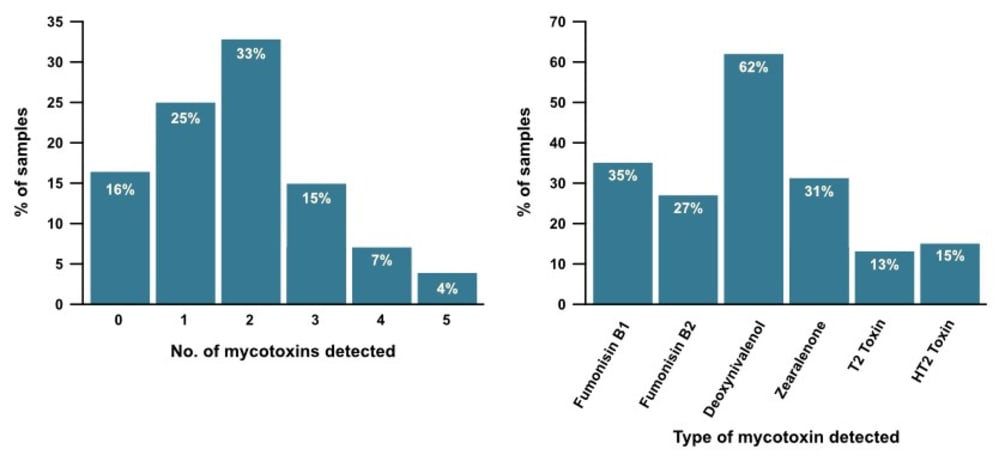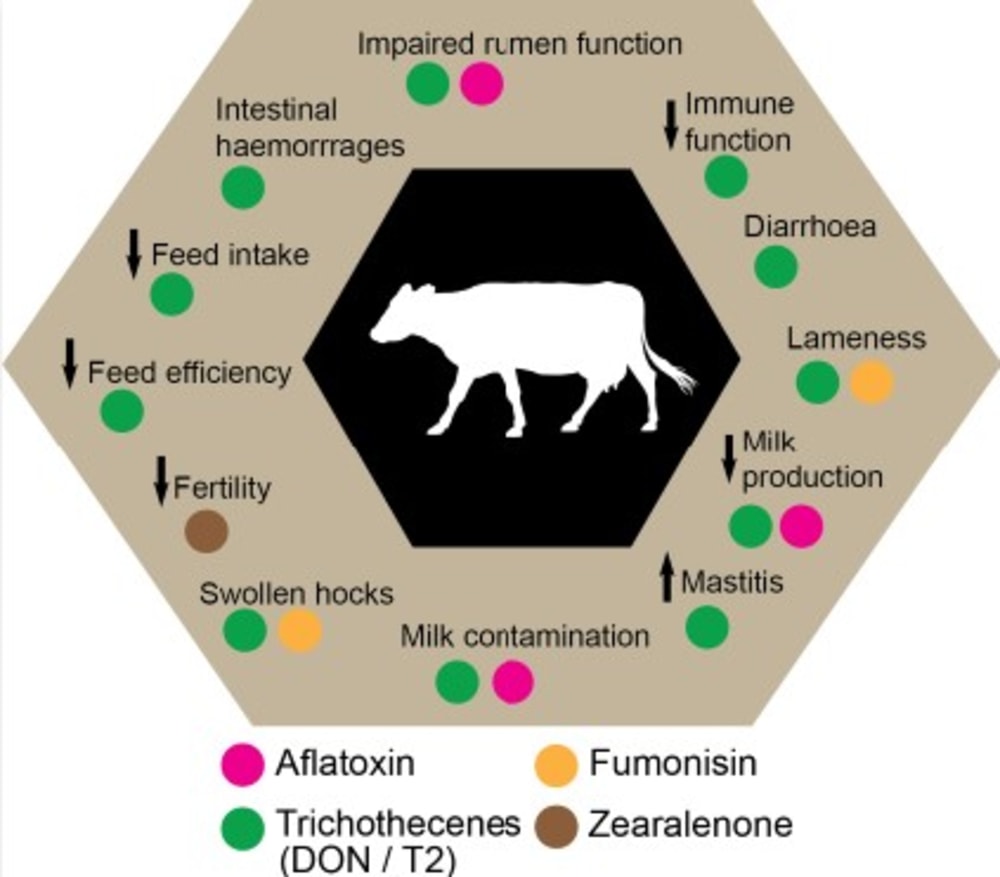Underestimating mycotoxin threat is putting cow performance and health at risk
Published Monday, 7th October 2019A higher risk of mycotoxins in winter rations this year could be negatively affecting milk yields, fertility and cow health. Dr Derek McIlmoyle explains.
With higher grass silage dry matters, many silage clamps overfull and low prices encouraging greater use of cereal grains, the risk of mould and mycotoxin contamination of feeds is on the rise, claims our EMEA Ruminant Technical Director Dr Derek McIlmoyle.
“The scale of the threat posed by mycotoxins continues to be overlooked by many, despite the substantial negative impact on cow performance, health and fertility,” he highlights. “Cereal grains are notorious sources of mycotoxins, whether produced by typical growing crop moulds like Fusarium or storage moulds such as Aspergillus.
“In addition, early analysis results from Trouw Nutrition show first and second cut grass silages averaging between 33-35% dry matter (DM), with wholecrop cereal silages closer to 38% DM. The grass silages are also tending to contain more fibre and lignin, so not only are many clamps overfull, but the material ensiled is both more bulky and harder to consolidate.”
Drier silages are known to be more prone to the growth of aerobic moulds, both whilst clamped – due to poor consolidation of damage to silage sheeting – and once opened for feeding out. And the problem is compounded as the aerobic spoilage and heating extends to the rest of the ration once mixed.
Mycotoxin testing results
Past mycotoxin testing of maize samples (grain and silage) from across Europe carried out by Micron Bio-Systems has confirmed the scale of the ongoing challenge posed by in-feed mycotoxins. Of the samples tested, 84% contained one or more mycotoxins, 58% contained at least two and 26% were contaminated with three or more mycotoxins (see Figure 1a).
“The most prevalent mycotoxin was deoxynivalenol (DON), which was present in 62% of the maize samples (see Figure 1b) and is highly damaging to ruminants,” Dr McIlmoyle explains. “DON is also unaffected by simple clay-based mycotoxin binders, and has to be physically transformed using specific active ingredients before it can be neutralised.”
a) Number of samples contaminated with mycotoxins. b) Level of individual mycotoxin contamination
Figure 1 – Mycotoxin levels in 2017-18 European maize samples (source: Micron Bio-Systems)
There’s currently little data available to show the full extent to which UK feedstuffs are contaminated with mycotoxins, but it’s an issue that affects more than just forages. Any feed that is grown outdoors, exposed to humidity or stored for any length of time is at risk, with mould growth likely to be accelerated by insect or mechanical damage, contamination with soil or bird faeces, or poor storage conditions.
Previous testing carried out in 2014, for example, found that 92% of all total mixed rations (TMR) tested contained mycotoxins, along with 82% of maize silages, 80% of barley samples and 75% of wheat samples.
Impact on production
“Many of the most damaging mycotoxins – DON, zearalenone (ZON) and T2 toxin – are produced by the Fusarium moulds that commonly affect growing feed crops,” Dr McIlmoyle continues. “Others, such as aflatoxin B1 (AFB1), are generated by the Aspergillus moulds typically seen in stored feeds.
“Some of the mycotoxins produced when crops are growing actually get combined with sugars within the plant. Although these ‘masked mycotoxins’ aren’t detected by standard mycotoxin testing, there’s evidence to suggest they can be released during digestion and add to the overall mycotoxin load on the animal.”
Common symptoms of mycotoxin ingestion are a reduction in milk yields, lower butterfat levels, worsening body condition and infertility (see Figure 2). Other indicators include rough coats, listless activity, inconsistent feed intakes, variable manure consistency and the presence of mucus tags – pieces of gut wall – in the manure.
Figure 2 – Effects of different mycotoxins on cow health and productivity
“Research has shown that dairy heifer conception rates fell from 87% to 62% where ZON was present in the ration,” highlights Dr McIlmoyle. “Even chronic lameness, foot lesions that won’t heal, or an increase in somatic cell counts, mastitis and cystic ovaries, can indicate a mycotoxin problem.
“The risk is also much greater when cows are suffering from sub-acute ruminal acidosis (SARA), which reduces the ability of rumen microbes to deactivate certain mycotoxins. In addition, SARA causes damage to the rumen wall that eases passage of those mycotoxins into the blood.”
Managing mycotoxin risk
It’s therefore extremely important to minimise the incidence of SARA when facing a mycotoxin threat. Avoid overloading the rumen with excess rapidly fermentable starch, consider adding a slow-release rumen conditioner such as Acid Buf to help stabilise rumen pH and take steps to reduce stress, such as overcrowding and competition for feed.
Paying close attention to feed storage, silage clamp management and feed hygiene is also critical to limit additional mould growth.
“Particularly this year, clamps are likely to be overfull, so good clamp management will be essential to avoid overheating and moulding,” Dr McIlmoyle advises.
“Visibly spoiled or mouldy material should always be discarded and feed-out areas cleaned daily to remove refusals. And if the ration is heating in front of the cows – a sure sign aerobic fungal growth is taking place – consider feeding less, but more often, to reduce the time available for spoilage.”
According to Dr McIlmoyle, many top herds are also now routinely including a high quality mycotoxin de-activator to protect cow health and production. A clear performance response within 2-3 weeks of adding a de-activator to the ration is indicative that mycotoxins are present at significant levels, an extra 2-3 litres/cow/day is not unusual.
“Just make sure it’s a broad spectrum, multi-component de-activator like UltraSorb R that’s been developed specifically for use in ruminants, and can act to ‘open up’ important mycotoxins such as DON for de-activation,” he adds.
“And avoid the basic clay-based binders. They’re not only ineffective against the likes of DON, but they can also bind with minerals and vitamins in the ration, making them less available.”
Latest news
Stay ahead with the latest news, ideas and events.

Online Feed Fibre Calculator
Calculate the percentage of dietary fibre in your feed
Our calculator is designed for nutritionists and uses averages of global raw materials to calculate the dietary fibre content (plus other more in-depth fibre parameters) of finished animal feed. These parameters are available within AB Vista’s Dietary Fibre analysis service (part of our NIR service).
Sign up for AB Vista news
A regular summary of our key stories sent straight to your inbox.
SUBSCRIBE© AB Vista. All rights reserved 2025
Website T&Cs Privacy & Cookie Policy Terms & Conditions of Sale University IDC policy Speak Up Policy


























